
San Sebastiano de Via Papae was a small church in the Sant'Eustachio rione of Rome that was demolished in the 1590s in order to enable the construction of the church of Sant'Andrea della Valle.

San Sebastiano de Via Papae was a small church in the Sant'Eustachio rione of Rome that was demolished in the 1590s in order to enable the construction of the church of Sant'Andrea della Valle.
The church's dedication to Saint Sebastian comes from a tradition that it was built on the spot where the Christian noblewoman Lucina rescued the saint's corpse from the sewer where it had been thrown after his martyrdom. [1] In regard to that tradition's historical reliability, the archaeologist Mariano Armellini is skeptical, but nevertheless deems it certain that the antiquity of the church means that it references some definite memory of the martyr. [1]
The designation of via Papae (Latin: way of the Pope), by which the church was commonly referred, recalls its location along a ceremonial papal route that began at the present site of Sant'Andrea della Valle and the piazza which stands in front of it, which before the sixteenth century was called Piazza di Siena. [1] For that reason, the church is called San Sebastiano in piazza di Siena in a catalog dating from the pontificate of Pope Pius V (1566–1572). [2]
The church is not to be confused with the similarly-named San Sebastiano in Via Pontificum, which was in the Borgo and had fallen into ruin by the pontificate of Pius V. [3]
The first surviving references to the small church of San Sebastiano date from the twelfth century, where it is listed in various registers of churches in the city of Rome. Although it was counted as a parish church, it remained subsidiary to larger churches in the neighborhood; it seems that it was originally among the dependent churches of San Lorenzo in Damaso, as is referenced in an 1186 bull of Pope Urban III. [2] In the thirteenth century, however, there arose a dispute over the church between the priests of San Lorenzo in Damaso and those of Sant'Eustachio, the resolution of which is noted in a bull of Pope Gregory IX dated April 9, 1231. [2] The apparent outcome was that its administration was transferred to the priests of Sant'Eustachio. [1]
The Codex Taurinensis of 1320 places the church in the third class, and records that ecclesia s. Sebastiani de via Papae habet unum sacerdotem ("the church of Saint Sebastian de via Papae has one priest"). [1] [4]
In the late fifteenth century, the church gained notoriety for an episode recorded in the diaries of Stefano Infessura (c. 1435 – c. 1500), which recounts how supporters of the Colonna and Della Valle families came to blows on the church's porch: [1]
| Dell'anno Domini 1482 a dì 4 d'aprile lo papa fece gittare in terra le case di misser Iorio Santa Croce et del fratello; et questo fece perchè la notte innanti lo ditto missor Iorio, con molti compagni armati et bene in ponto, assaltaro casa di missore Liello et di Iacovo della Valle; et poseronsi nello porticale di Santo Sebastiano, et lì combattendo contra ad quelli della Valle, uccisero lo signore Ieronimo Colonna, figlio naturale tantum dello prefetto della Colonna ... [5] | In the year of the Lord 1482 on the fourth day of April, the Pope razed to the ground the homes of Iorio Santa Croce and his brother; and this he did because the night before, the same Iorio, with many companions (armed, and very much so), assaulted the home of Liello and Giacomo della Valle; and positioning themselves in the portico of San Sebastiano, and fighting there against those who belonged to della Valle, they killed Geronimo Colonna, the full natural son of the prefect of the Colonnas. |
The church was demolished under Pope Sixtus V together with the adjoining parish house in order to enable the construction of the much larger and grander church of Sant'Andrea della Valle. [1] A papal brief of August 18, 1590, however, stipulates that because Sant'Andrea would "embrace and enclose" the site of the former church of Saint Sebastian, there ought to be an altar dedicated to that saint inside the new one. [1] As a result, there is a side chapel in Sant'Andrea della Valle in honor of Sebastian and a statue of him on its facade, both of which serve to perpetuate the memory of the demolished church.
Another remnant of the vanished church is discernible in the Barberini Chapel of Sant'Andrea. In that chapel, which is the first on the left as one enters the church, there is a small chamber, which is separated by an ironwork grill from the rest of the chapel. [6] This spot marks the location where Sebastian's body was reputedly recovered, and where the high altar of the former church once stood. [6] Furthermore, the feast day of Saint Sebastian has historically been celebrated with special festivity in Sant'Andrea. [7]
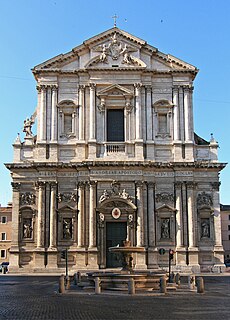
Sant'Andrea della Valle is a minor basilica in the rione of Sant'Eustachio of the city of Rome, Italy. The basilica is the general seat for the religious order of the Theatines. It is located at Piazza Vidoni, 6 at the intersection of Corso Vittorio Emanuele and Corso Rinascimento.

There are more than 900 churches in Rome, including some notable Roman Catholic Marian churches. Most, but not all, of these are Roman Catholic.

San Callisto is a Roman Catholic titular church in Rome, Italy, built over the site of Callistus I's martyrdom. The original building dates from the time of Pope Gregory III, who ordered the building of a church on the site. The church has been rebuilt twice since, first in the twelfth century, and the current church in 1610. In 1458 Callixtus III decreed it a titular church as a seat for Cardinals.

The Church of Saints Martin and Sebastian of the Swiss is a Roman Catholic oratory in Vatican City. The church was built by Pope Pius V in 1568 to serve as a private chapel for the Pontifical Swiss Guards, whose barracks are located next to Porta San Pellegrino, close to the Apostolic Palace. It is considered the national church of Switzerland in Rome.

The Church of San Pellegrino in Vaticano is an ancient Roman Catholic oratory in the Vatican City, located on the Via dei Pellegrini. The church is dedicated to Saint Peregrine of Auxerre, a Roman priest appointed by Pope Sixtus II who had suffered martyrdom in Gaul in the third century. It is one of the oldest churches in the Vatican City.
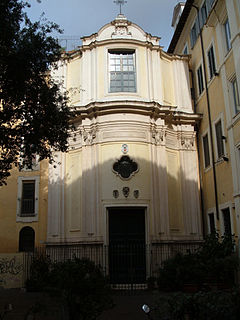
Santa Maria della Quercia is a Roman Catholic church located on the piazza of the same name, one block southeast of the Palazzo Farnese in the Rione (district) of Regola of central Rome, Italy.

Santi Celso e Giuliano is a minor basilica church in Rome, Italy. It has held this status by custom and practice since ancient times. The church is located on Vicolo del Curato number 12, just off Via del Banco di Santo Spirito, the road leading to Ponte Sant'Angelo.
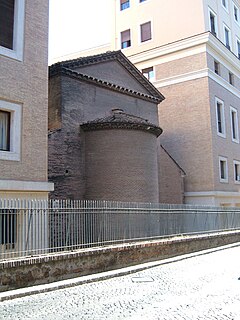
The Church of San Lorenzo in Piscibus is a 12th-century small church in the Borgo rione of Rome. It is located near Saint Peter's Square and Vatican City, but its façade is not visible from the main street, Via della Conciliazione.
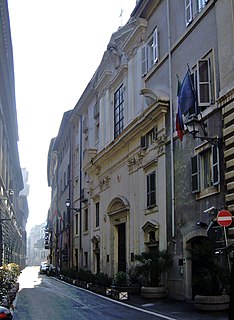
Santissimo Sudario all'Argentina or Santissimo Sudario dei Piemontesi is a church in Rome, sited on the via del Sudario in the Sant'Eustachio district. It is the subsidiary church of the military orders in Italy. It was also once the national church of the Kingdom of Sardinia and is now the regional church for Piedmont and Sardinia. It houses a replica of the Turin Shroud.

Santa Caterina da Siena is a church in Rome dedicated to Catherine of Siena. It is sited on via Giulia in the Regola district.

Santa Maria della Concezione is a church in Rome, located on Piazza Campo Marzio in the Campo Marzio rione.

Santo Stanislao dei Polacchi, also known as San Stanislao alle Botteghe Oscure is a Roman Catholic church in Rome, sited on via delle Botteghe Oscure in the Sant'Angelo rione. It is the national church of Poland in Rome.
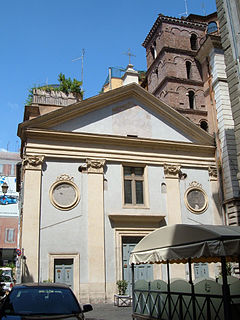
San Salvatore alle Coppelle is a church in Rome, on piazza delle Coppelle in the Sant'Eustachio district.

The church of Sant'Egidio in Borgo, ...a Borgo, or ...in Vaticano, is a Roman Catholic oratory in Vatican City dedicated to Saint Giles.
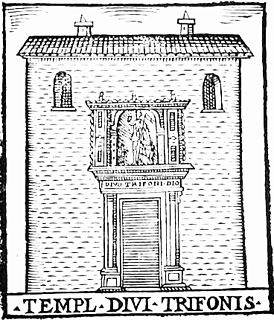
San Trifone in Posterula was an ancient titular church of Rome, now lost. It was located at the corner of Via dei Portoghesi and Via della Scrofa, in the Campo Marzio rione of the city.

Santi Sergio e Bacco al Foro Romano also called Santi Sergio e Bacco sub Capitolio was an ancient titular church in Rome, now lost. Located in the ruins of the Roman Forum, it had been one of the ancient diaconiae of the city and a collect church for one of the station days of Lent, but it was demolished in the sixteenth century.

Santa Lucia in Septisolio was an ancient Roman church with a diaconia. It formerly stood at the base of the Palatine Hill, near the Septizodium of Septimius Severus, from which it took its name. The date of its destruction is not certain, although it seems to have disappeared definitively after the pontificate of Sixtus V (1585–1590).
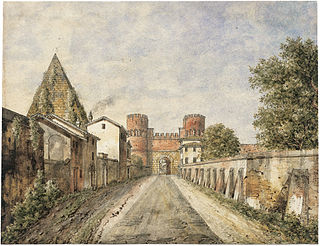
San Menna was an ancient church in Rome, formerly located along the Via Ostiensis which led to the Basilica of Saint Paul. It appears to have been destroyed at some point after the tenth century.
San Ciriaco de Camiliano was an ancient church of the city of Rome, formerly located on the present site of the Piazza del Collegio Romano near the Via del Corso. It was demolished in 1491 during construction on the church of Santa Maria in Via Lata.

Santa Maria in Monterone is a Roman Catholic church in Rome, Italy. Its suffix originates from the Sienese Monteroni family, whose patronage rebuilt the church and built a small hospice next to it for pilgrims from Siena. It is located on Via Santa Maria in Monterone in the Sant'Eustachio rione. Next to the church is a Redemptorist monastery, whose clergy manage the church.